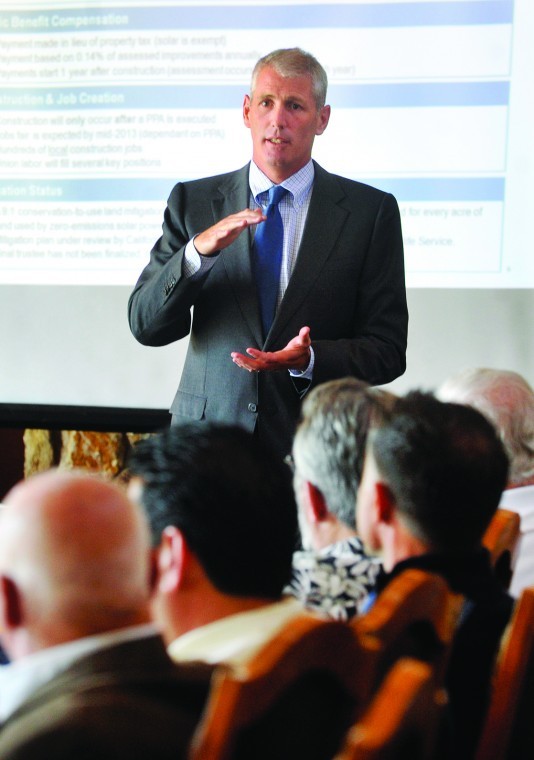
Shani Kleinhaus believes the Panoche Valley could become a refuge for many species and she sees its big solar project—awaiting state and federal permits—as a roadblock toward that and other environmental goals.
“I don’t see how they can build this project without fragmenting and deteriorating the habitat for species,” said Kleinhaus, environmental advocate for the Santa Clara County Audubon Society.
Panoche Valley Solar Chief Executive Officer John Pimentel, though, countered that the project benefits far outweigh any negative impacts, particularly due to efforts that would significantly shrink the total project area and set aside a significant swath of open spaces.
“We believe that the agencies will ultimately issue permits due to our strong biological fact base and the significantly beneficial conservation outcome on the project,” said Pimentel, who hopes to start construction by the fall.
The two perspectives represent a six-year—possibly winding down soon—debate between supporters of the 247-megawatt project in San Benito County and detractors who point to environmental impacts as a reason to halt it.
Kleinhaus underscored expected consequences on such species as the blunt-nosed leopard lizard and kangaroo rat, along with an array of birds, as reasons to reject it.
“It’s not called a globally significant bird area for nothing,” she said, referring to a designation from the Audubon Society and Bird Life International.
In an interview with the Free Lance, she said the Panoche Valley would be a lost resource—if the project goes through—for members of her organization who visit the area to view birds.
“More than 500 birders visit the valley every year,” Kleinhaus said, noting how it’s an impressive number for such a “small, remote place.”
Her chapter of the Audubon Society is among the opponents to the project hitting a final stride as it awaits permitting approval from four agencies at the state and federal levels, including a crucial environmental impact statement—the federal equivalent of an environmental impact report in local government—from the U.S. Army Corps of Engineers.
Pimentel and other financial backers—early investors from PV2 recently partnered with the Renewable Energy Trust on a deal for the $650 million project—have gradually increased the amount of open spaces set aside in the agreement to about 24,000 acres, or what project proponents tout as a 10-to-1 ratio when compared with the actual size of the solar farm.
Pimentel, meanwhile, downplayed the holdup from the four state and federal agencies.
“They’re really down to the very minor items,” he told the Free Lance, “and we’re continuing to answer their questions in order to ensure that the permits, when issued, have contemplated all the potential issues.”
Asked further on conditions being discussed at the agency level and Pimentel responded, “We’re really down to the details of the permit conditions and how to provide for the enforcement of the permit conditions, and that sort of thing.”
Kleinhaus, however, remains confident in her group’s case and the outcome it’s pursuing, especially with a pending deadline at the end of next year for the solar developers in order to receive a federal tax credit. She noted how, for instance, the Army Corps of Engineers’ EIS process will include, even if published soon, a 30-day comment period and a follow-up period for responses.
“I think it would be an uphill climb for them, a steep uphill climb for them,” she said.
Pimentel is confident, though, and mentioned the developers could take out “slack” from the construction budget in order to tighten the schedule.
Pimentel stressed that developers have been “working hard” to address any concerns at the site.
“We’ve been quite confused by why some environmental groups don’t want to see a solar project in San Benito County,” he said.
Organizations opposed to the project include Santa Clara Audubon Society, Audubon California, Sierra Club, Center for Biological Diversity and Defenders of Wildlife, along with local residents largely living in the Panoche area.
Locally, there has been a broad spectrum of support for the solar project among government, nonprofit and business interests, many pointing to the economic benefits it would offer while producing renewable energy.
The investors are betting big that four state and federal agencies will give clearance to the solar project on 2,400 acres in Panoche Valley. Those business interests are pressed up against a deadline as they must complete the project—with an expected 18-month construction schedule—by the end of 2016 to receive a 30 percent tax credit from the federal government.
Locally, the San Benito County Board of Supervisors on May 19 gave its final go-ahead, on an appeal of the revised environmental review for a scaled-down version of the original plans first broached publicly six years ago.
Solar project spokeswoman Kristina Chavez Wyatt confirmed to the Free Lance that investors had spent $20 million on pre-construction efforts—to ensure they can break ground promptly after getting a final government OK—and more than $50 million in total with application efforts included.
Developers plan to hire an estimated 500 workers during the construction phases. Initially, they had planned four phases. Now they are looking at two, and possibly one longer phase, due to the time constraint, Chavez Wyatt said.
It’s a long way from 2010 for project supporters. A local group calling itself Save Panoche Valley and the Santa Clara Audubon Society filed a lawsuit in November 2010 against PV2 and the county attempting to halt the project due to environmental concerns. A visiting judge in August 2011 ruled against the groups. In June 2013, the Sixth District Court of Appeal once again sided with solar developers and the county.
Look back for more.









